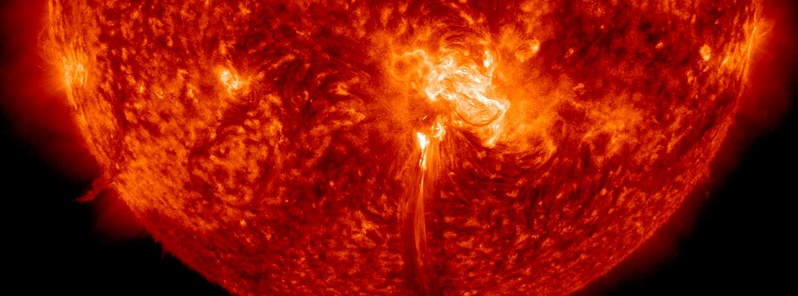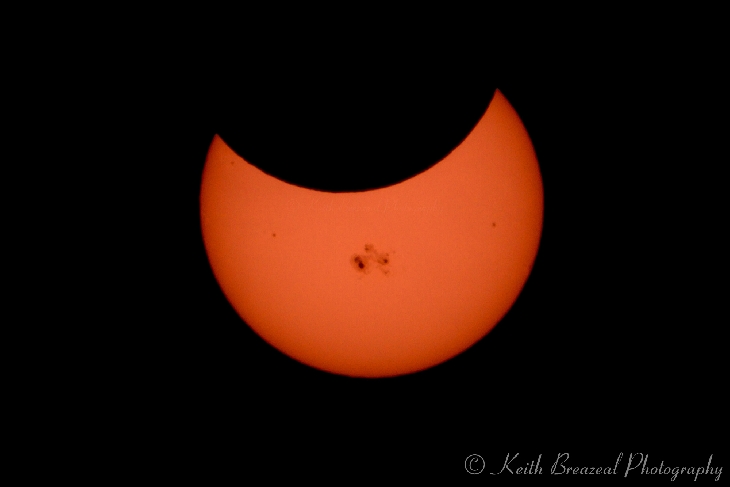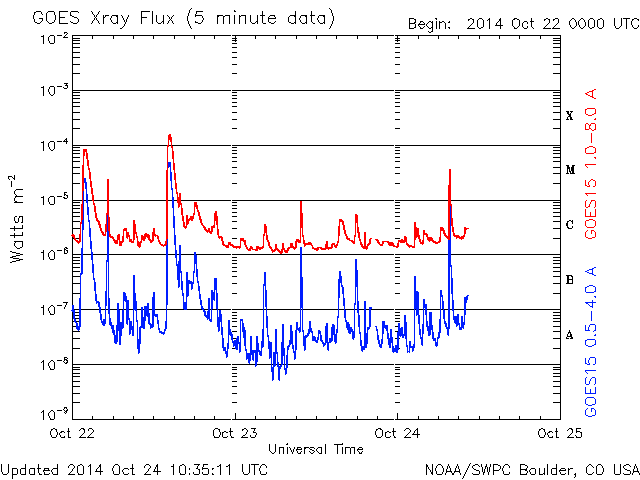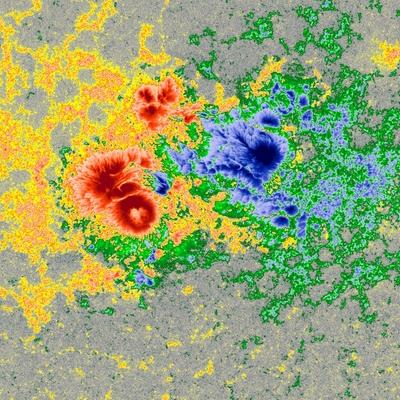Impulsive M4.0 flare erupted from central region on the Sun

A moderately strong and impulsive solar flare measuring M4.0 at its peak time erupted from huge central region on the Sun on October 24, 2014 at 07:48 UTC. The event started at 07:37 and ended at 07:52 UTC.
A Type II (664 km/s) and IV radio emission were associated with the event. Type IV emissions occur in association with major eruptions on the Sun and are typically associated with strong Coronal Mass Ejections and solar radiation storms.
The source of today's M4.0 flare Region 2192 located almost at the center of the disk. This region has 'beta-gamma-delta' magnetic configuration and is capable of producing more strong to major eruptions on the Sun. Earth directed CMEs from this region are now highly likely.
Region 2192 is the largest sunspot of this cycle and this is how the it looked like on October 23 during partial solar eclipse:

Taken by Keith Breazeal on October 23, 2014 @ Volcano, California (via SpaceWeather)


Space Weather Message Code: ALTTP2
Serial Number: 969
Issue Time: 2014 Oct 24 0838 UTC
ALERT: Type II Radio Emission
Begin Time: 2014 Oct 24 0755 UTC
Estimated Velocity: 664 km/s
Description: Type II emissions occur in association with eruptions on the sun and typically indicate a coronal mass ejection is associated with a flare event.
***
Space Weather Message Code: ALTTP4
Serial Number: 485
Issue Time: 2014 Oct 24 0838 UTC
ALERT: Type IV Radio Emission
Begin Time: 2014 Oct 24 0759 UTC
Description: Type IV emissions occur in association with major eruptions on the sun and are typically associated with strong coronal mass ejections and solar radiation storms.
***
.jpeg)
.jpeg)
.jpeg)
.jpeg)
Sunspots
There are currently 5 numbered sunspot regions on the Earth side of the Sun. Region 2192 showed signs of separation between its leader and trailer spots yesterday although it continued to grow and remained magnetically complex. For several days in a row it is the sole source of flaring on the Earth side. All other regions on the disk are relatively stable.


Sunspots on October 24, 2014. Image credit: NASA SDO/HMI
2187 – Alpha
2192 – Beta-Gamma-Delta
2193 – Beta-Gamma
2194 – Beta
2195 – Beta
Active Region 2192
October 24, 2014


Image credit: NASA SDO / HMI
Forecast
R1-R2 (Minor-Moderate)/(85%) flares are expected with a chance for R3 (Strong)/(45%) activity over the next three days (October 24 – 26) due to flare potential from Region 2192.
The greater than 2 MeV electron flux was high yesterday, reaching 6,900 pfu at 23/13:40 UTC. The greater than 10 MeV proton flux remained at background levels.
The greater than 2 MeV electron flux is expected to be at moderate to high levels for the next three days. There is a chance for a greater than 10 MeV proton enhancement at or above the S1 (Minor) level for the next three days as Region 2192 moves into an increasingly threatening position on the solar disk.
Observations from the ACE spacecraft reflected relatively nominal conditions over the past 24 hours. Wind speed remained mostly in the 400-460 km/s range. Phi remained positive, while Bt remained at or below 6 nT. The Bz component was variable between +/-5 nT.
An equatorial positive polarity coronal hole high speed stream (CH HSS) is expected to be reflected at ACE over the next three days if it is well connected.
The geomagnetic field was at quiet to active levels due to extended periods of negative Bz and is expected to reach unsettled to active levels, with a slight chance for a minor storm period, on October 24 with the onset of the next CH HSS. Conditions are expected to diminish to quiet to unsettled levels by day two October 25 and into October 26.
Featured image: NASA SDO AIA 304 on October 24, 2014 at 08:54 UTC.

Commenting rules and guidelines
We value the thoughts and opinions of our readers and welcome healthy discussions on our website. In order to maintain a respectful and positive community, we ask that all commenters follow these rules.